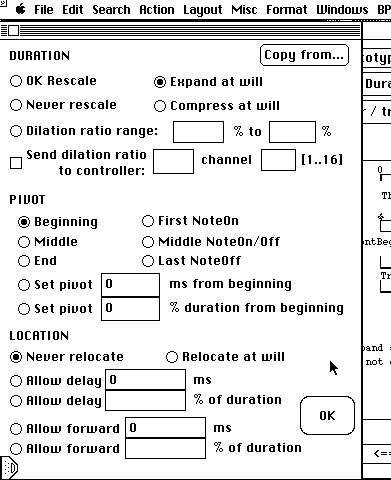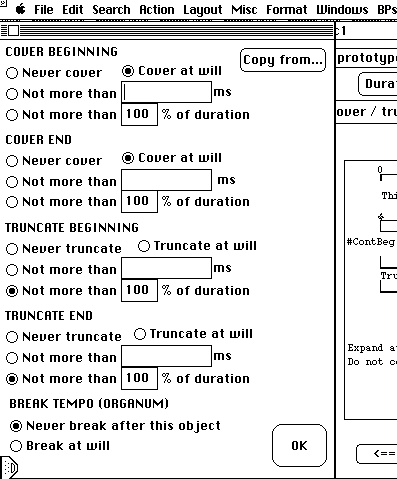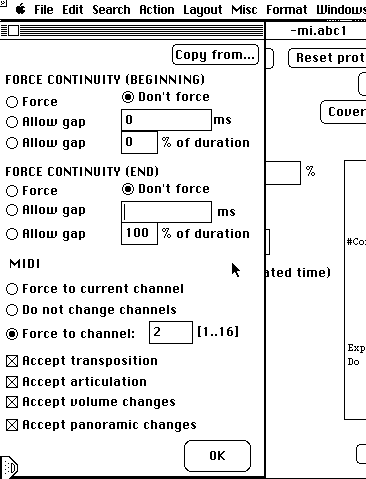3. Sound-object prototypes
(A formal introduction to sound-objects
may be found in Bel 1991,1992a)
A string of terminals and structural
symbols generated by the Bol Processor is converted to MIDI messages in the
following way: each terminal represents a sequence of MIDI codes or a "
musical gesture" recorded from a MIDI
instrument. We call these sequences
sound-object prototypes.
Sound-objects are generally not
performed at the same speed they have been defined. Their time-scale depends
both on the tempo of the performance and on certain properties assigned to their
prototypes.
3.1 Metrical properties of sound-objects
The position of an object in relation to
time streaks is calculated on the basis of some
properties introduced now. We use the names of properties as per previous
publications. These appear more explicitly in the new BP2 interface.
Property
PivBeg means that the streak position is the
first MIDI message of the object prototype.
PivEnd means the last message.
PivCent means the centre.
PivBegOn means the first NoteOn.
PivEndOff the last NoteOff.
PivCentOnOff means the centre of the time-span
interval starting on the first NoteOn and ending on the last NoteOff.
PivSpec is a general case in which the time
offset between the first MIDI message and the streak is specified. These
properties are explicitly shown in the dialog Fig.2.
 Fig.2 Editing metrical sound-object properties
Fig.2 Editing metrical sound-object properties
Fig.2 shows that the pivot location may
either be defined absolutely (in milliseconds) or as a percentage of the
object's duration. In the latter case, it will be modified according to the
current time base of the performance if the object has properties OkRescale,
OkCompress or OkExpand.
OkRescale
means that this object may be expanded or compressed according to the time base.
FixScale means it can't.
OkCompress means it can be compressed,
OkExpand that it can be expanded. (See explicit
representation on Fig.2) Indeed, if OkRescale is true, then all other
properties except FixScale are made true. The scaling of an object is expressed
by the
dilation ratio
a. If
a> 1
then the sound-object is performed slower than its prototype. The dilation
ratio may be confined to a range deemed acceptable for the sound-object (see
Fig.2). Periodical sound-objects are handled in a
different way, see §2.5.
The value of
amay be
sent to the MIDI device (before the sound-object is performed) in case the sound
processor is able to make sense of it for modifying parameters in synthesis
algorithms. (Most commercial synths don't.) The current value of
ais
encoded logarithmically in range 0.01 to 100, and the MIDI controller value is
so that
a
= 0.01 will yield 0 and
a
= 100 yields 128. If you want this value to be
passed to the sound processor each time this particular sound-object is
performed, then check "Send dilation ratio to controller".
"Relocate at will" (
Reloc) means that the pivot of the object may be
located far from the time streak if necessary. "Never relocate"
forces location on the time streak. Relocation may also be allowed within
specific limits (see Fig.2).
3.2 Topological properties of sound-objects
 Fig.3 Editing topological sound-object properties
Fig.3 Editing topological sound-object properties
OverBeg
means that the beginning of the sound-object may overlap the end of an object
preceding it in the same sequence.
OverEnd means that its end may overlap another
object following it in the same sequence.
TruncBeg means that the beginning may be
truncated if it overlaps an object in the same sequence.
TruncEnd means that the end may be truncated if
it overlaps an object in the same sequence. These properties (see Fig.3) may
also be assigned within absolute or relative limits.
BrkTempo
means that the object may "break" the striated structure (
organum).
Continuity properties are shown Fig.4.
ContBeg means that the beginning of this object
should join (or overlap) the end of a preceding one in the same sequence.
ContEnd means the end of this object should join
(or overlap) the beginning of a following one. These properties may be
compensated with a tolerance for a gap preceding or following the object.
 Fig.4 Editing continuity and MIDI properties
Fig.4 Editing continuity and MIDI properties
MIDI properties
(see Fig.4) instruct BP2 how to deal with channel, transposition, articulation,
volume and panoramic changes as far as this object is concerned.
Given these sets of properties (stored
in the "-mi." file) and a setting of the time base, BP2 will try to
set all objects in time. For this it may need to relocate some of the objects
that have Reloc or BrkTempo properties, truncate other objects, etc. If there
is no solution, BP2 may release some of the constraints. (See operational mode
§5.2)








